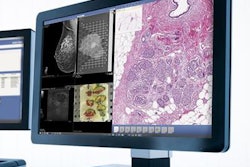
People wanting to try out AI technology have a plethora of questions, not the least of which is wondering which vendors will be around five years from now and which will not. To project where AI may be in the future, though, you should first remember some lessons from the past.
Many consider AI to be a part of PACS, but PACS was designed to completely eliminate film and all associated areas relating to film -- from lightboxes and alternators to film file rooms. AI is merely a software application that's designed to provide added value to the radiologists' interpretation and reporting. It is nothing more and nothing less, at least not as of now.
 Michael J. Cannavo.
Michael J. Cannavo.As background, PACS has been around since the mid-1980s but didn't get adopted in widespread fashion until well over a decade later. Since that time, there have been at least 300 companies entering and exiting the PACS marketplace. This includes teleradiology providers and vendors in other areas of image management. Of those, 40, at best, are still competing in today's marketplace and maybe a dozen are profitable.
Now let's look at AI. If the more than 120 vendors in the AI medical imaging space were to be on ABC's "Shark Tank" show, 100 would not get a deal, 15 would get a deal but would have to give up a much higher percentage of their company to secure the requested funding, and five would get whatever they were asking for and maybe even have the sharks fighting to partner with them. Nearly all would also have a much lower valuation than they came in looking for, at least for now.
For every Scrub Daddy, Squatty Potty, and Ring doorbell that made the "Shark Tank" investors and their pitchers a small fortune, there were also the Body Jacs, Toygaroos, and Sweet Ballz cake balls that never hit the big time and lost them all money. Sadly, if history repeats itself, most of the AI vendors may fall into the latter category.
Investments made on "Shark Tank" are also typically under $250,000 and show high growth and a return on investment (ROI) within a year or so. However, most initial investments for AI in medical imaging are slightly over $9 million in a market that is just developing. Nearly all will require several more rounds of venture capital funding just to stay alive, let alone turn a profit. Best guesstimates are saying that the average AI company will need at least $40 million to $50 million just to be competitive. This leads to the sad reality that the vast majority of AI companies may never make it.
A crowded field
In addition, many more initial players are in the AI space now than were in the PACS marketplace in years past. AI supporters will say that because various AI algorithms address different areas -- radiology, cardiology, oncology, neurology, etc. -- most of the AI vendors will survive because they have little direct competition. That seems logical until you consider the burn rate of capital related to the AI space. It's simply astounding how much money is being brought in and how much money is going out.
Most companies simply can't continue to burn through money at the pace they are now until the AI market finally develops. Venture capitalists (VCs) have to figure out when to hold 'em and when to fold 'em, and very few have (or seem to have) the expertise to help them make an informed, objective, intelligent decision.
So what will it take to have the AI market continue to grow? Time and a lot of money. Most VCs accept the pitches made by prospective AI companies as gospel with few, if any, asking serious questions -- or at least asking those that should be asked. Most look at the growth that AI has in nonimaging applications and how easily and readily the technology is being embraced there, and they figure AI in medical imaging is a sure thing. That is not the case.
Most VCs also make gut decisions referencing these nonmedical applications without considering the reality of the requirements of using AI within medical imaging. After all, the next logical area for AI to conquer is healthcare, and in many respects they are correct. AI has shown promise in many areas so far in healthcare, just not nearly as extensively in medical imaging as in other areas. AI has actually shown much more promise to date in cardiovascular applications than in general radiology because of the dollars involved as well as dollars invested. The rest of the market seems to be lagging behind.
It's interesting to note that most of the profit on PACS has been generated by service agreements, not the sale of the systems themselves or even the software. PACS service agreements can easily generate $100,000 to $2 million or more per year based on a system size.
By comparison, most, but not all, of AI profit comes from software as a service (SaaS) billing related to use of the algorithm. At $1 to $5 per case, on average, even high-volume, high-use AI algorithms like chest, breast density, and others will take a lot of billing to pay back the investments made in AI regardless of how many facilities are using it. AI must also pay for itself through reimbursement, either from the U.S. Centers for Medicare and Medicaid Services (CMS) or private insurers. None of that has happened to date.
To be fair, though, the AI companies do get paid some when the algorithm is put in place, but integrating the software into the PACS and other clinical systems offsets much of that.
Need for acceptance
To be a success, AI also has to be accepted by the imaging community. As yet, this hasn't happened either, at least not in a widespread manner beyond the academic and luminary facilities in the U.S. that are conducting AI trials. Despite studies that have documented the power of AI, a very high level of skepticism still exists over the value of AI technology.
Many question what AI brings to the table (in terms of value), how it impacts the radiologists, how it's going to be paid for, and whom it benefits most (which also correlates with how it is going to be paid for). Also, do the algorithms have the U.S. Food and Drug Administration (FDA) 510(k) clearance needed for clinical use?
Above all, AI has to seamlessly integrate with the current reporting workflow, meaning that the AI report is readily available when the current study is ready to be interpreted. It can't come after the fact as that will negatively impact workflow and, as we have said time and again, workflow is everything. Interfacing to PACS is also not easy or cheap, with most companies still using customized application programming interfaces (APIs) instead of containers like Docker, Kubernetes, and others.
What would I do if I were an investor in AI? I would first prepare those on my investment team to go the distance financially for at least five, and reasonably 10, years. I would also have someone look over the company's go-to-market strategy at regular intervals and assess how the investment is being utilized. A company may not be profitable yet, but if it has its 510(k) clearance to market in the U.S., testimonials, a solid research and development team, and if it spends its money the right way, that's all that's really needed to feel confident. The latter point is crucial.
Spending the right way
The heads of most AI companies put the most money into the areas they know the best. For many, this is product development. However, five years from now they will undoubtedly have the best product in their specific development area that no one knows about because no money was left for sales and marketing. The average cost to attain a customer is also sky high and needs to be cut by at least 75% or more.
Beyond the simple education that the AI market still desperately needs, AI needs marketing from companies to be focused and directed, not the mindless drivel I have seen from ad agencies so far. One AI ad that sticks out in my mind was obviously targeted at radiologists because it talked about radiologist burnout yet showed a "radiologist" reading a CT study from a single monitor in a room with all the lights on. The monitor also showed a single CT body mage occupying more than half the screen yet never specified the region actually targeted by the AI algorithm. To learn more about this product, you had to either watch a video or download a paper entering your life history just to get it.
It's also interesting that the ad addresses the radiologist since, more often than not, it's the hospital that will be spending the money for AI. To that end, the ad also said nothing about what's in it for the hospital and how it will show an ROI, let alone potentially improve patient care. What's wrong with that picture?
AI must become a need-to-have product that helps improve both patient care and the radiologic interpretation process instead of a nice-to-have product that merely makes someone's life easier. We will get there, but when is anyone's guess.
Michael J. Cannavo is known industry-wide as the PACSman. After several decades as an independent PACS consultant, he worked as both a strategic accounts manager and solutions architect with two major PACS vendors. He has now made it back safely from the dark side and is sharing his observations.
His healthcare consulting services for end users include PACS optimization services, system upgrade and proposal reviews, contract reviews, and other areas. The PACSman is also working with imaging and IT vendors developing market-focused messaging as well as sales training programs. He can be reached at [email protected] or by phone at 407-359-0191.
The comments and observations expressed are those of the author and do not necessarily reflect the opinions of AuntMinnie.com.



















